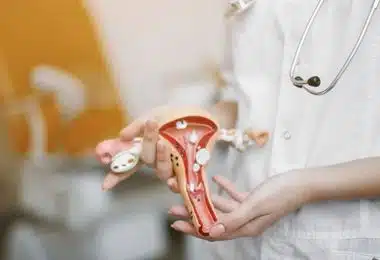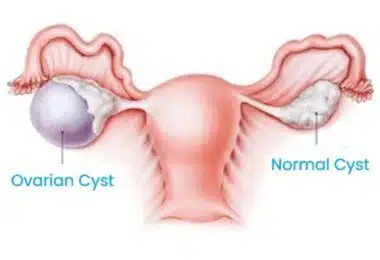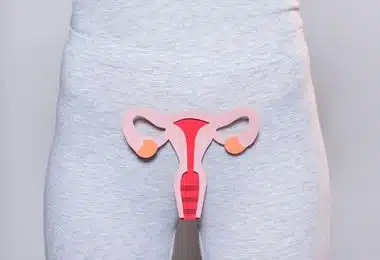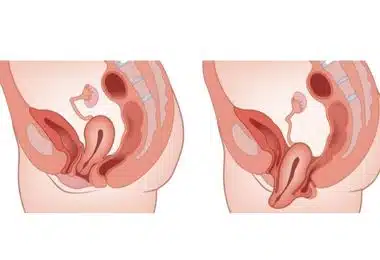
Endometrial Polyps
November 15, 2022
Ovarian Cyst
November 15, 2022
Endometrial Polyps
November 15, 2022
Ovarian Cyst
November 15, 2022
Uterus, and Rectum (Pelvic Organ Prolapse)
Pelvic organ prolapse is a prolapse of the bladder, uterus, and rectum (organs that should be located in the abdominal cavity), associated with sagging of the anterior wall of the vagina. As you know, the uterus is the place where conception, growth, and subsequent excretion of the fetus through active efforts (childbirth) occur during pregnancy. Behind the pubic joint (pubic bone) is the bladder, uterus, and rectum, respectively.

Image-1: Pelvic organ prolapse.
The uterus, as the upper part that holds the dome of buildings from the Roman era, contributes to the retention of these three organs due to its strong ligaments. The muscles and connective tissues of the pelvis also help to keep the bladder and rectum in their natural places.
Why Does Pelvic Organ Prolapse Happen?
Prolapse of the uterus, bladder, and rectum is a common problem in women. The causes of pelvic organ prolapse are associated either with factors that increase the constant intra-abdominal pressure or with the weakness of the supporting structures. Constant weightlifting, chronic coughing, or straining are the causes of increased intra-abdominal pressure. An increase in intra-abdominal pressure will cause an increase in pressure on the edges of the intra-abdominal space. The abdominal cavity is surrounded by relatively strong structures – the diaphragm on top, and the abdominal muscles on the sides. Potentially, the weakest point is the area of the vagina, and therefore the constant increased pressure leads to the displacement of these organs outwards in this area. Another reason for the prolapse of the uterus, bladder, and rectum is the weakness of the ligaments and muscles of the area that provide strength.
What Complaints Does Pelvic Organ Prolapse Cause?
Pelvic organ prolapse can cause both general and local pain, depending on the sagging organ. Since the bladder is located in the front, it first causes a soft mass to form at the entrance to the vagina. Women may experience pain during sexual intercourse, sometimes during sneezing or coughing, involuntary urinary incontinence may occur due to the downward movement of the bladder, and sometimes it can cause complaints such as difficulty urinating, recurrent urinary tract infections, and vaginitis. With severe sagging of the bladder, which continues for many years, there may be problems of the ureter (the organ through which urine from the kidneys enters the bladder), leading to stagnation of urine and further damage to the kidneys. A sagging uterus can cause a feeling of heaviness, enlargement of the vagina, and pain during sexual intercourse. Rectal prolapse can cause complaints such as a feeling of heaviness in the vaginal area, vaginal enlargement, difficulty emptying the intestines, and, as a result, constipation.
How Is the Pelvic Organ Prolapse Treatment Done?
The most common procedure performed after the appearance of sagging is surgery. Patients who are unable to undergo surgery for any reason may be prescribed individual treatment methods (for example, the use of a pessary). As with any disease, the priority should be preventive approaches to prevent the disease. For this reason, to prevent the omission of organs, it is worth paying attention to some points. It is necessary to refrain from actions that constantly increase intra-abdominal pressure (coughing, lifting weights), to prevent damaged pelvic structures (in severe childbirth), and not to forget that smoking, as well as obesity, leads to a weakening of the pelvic muscles. Besides, exercises such as Kegel exercises used to strengthen the pelvic muscles can slow down and prevent sagging organs. There are many options for surgical intervention in the treatment of pelvic organ prolapse. Some of these operations may be performed vaginally, and some may be performed abdominally. Abdominal operations can be performed using open or closed surgery (laparoscopic surgery). Some surgical procedures for the correction of prolapse use synthetic materials, while others do not. It is reported that vaginal surgeries have a slightly higher risk of recurrence than abdominal cavity (abdominal) surgeries. Among the operations performed by the abdominal route, there are surgical methods with a very low risk of relapse, guaranteed for life. The most appropriate operation is usually determined by the patient’s condition and the surgeon’s experience.
Our international articles published on this topic
Effect of reproductive characteristics, body mass index, and anterior/posterior vaginal compartment defects on the short-term success of abdominal sacrocolpopexy. Çağlar M, Erkal NB, Isenlik BS, Özdemir Ö, Yavuzcan A, Üstün Y, Kumru S.J Obstet Gynaecol. 2015;35(5):512-6. doi: 10.3109/01443615.2014.970525.PMID: 25356618.

